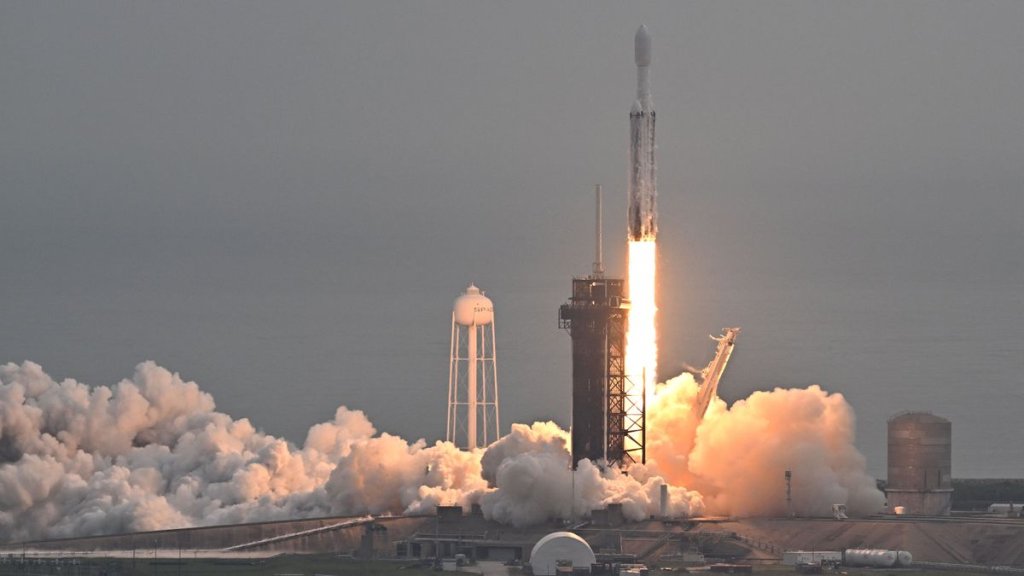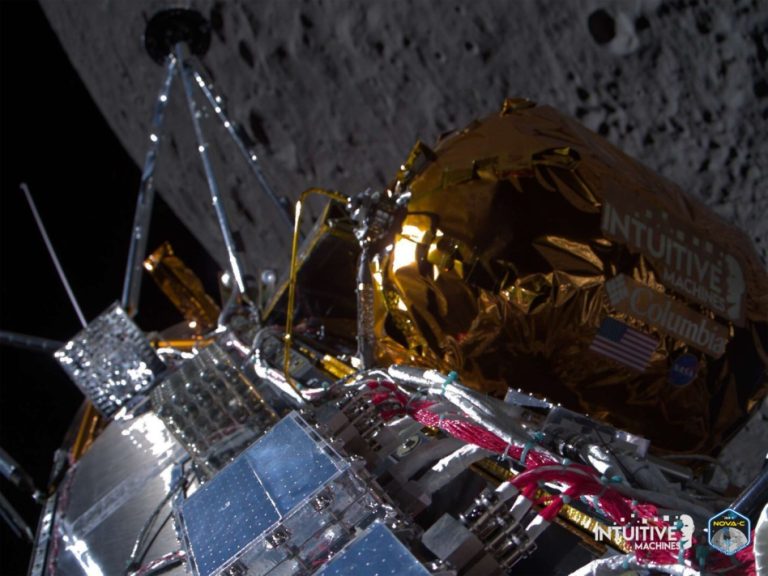
SpaceX Falcon Heavy rocket launches NASA’s Psyche probe to bizarre metal asteroid (video) (Image Credit: Space.com)
CAPE CANAVERAL, Florida — NASA’s Psyche spacecraft launched this morning (Oct. 13) from Pad 39A here at the agency’s Kennedy Space Center (KSC). The asteroid-bound probe lifted off atop a SpaceX Falcon Heavy rocket, marking a list of firsts for NASA and the launch vehicle.
Not including SpaceX CEO Elon Musk‘s Tesla Roadster, which launched past the orbit of Mars on Falcon Heavy’s debut test flight in February 2018, Psyche is the rocket’s first official interplanetary mission. It is also the first NASA mission to launch on a Falcon Heavy.
Liftoff occurred at today 10:19 a.m. EDT (1419 GMT). The triple-booster rocket ignited all 27 of its first-stage Merlin engines, which produce up to 5 million pounds of thrust at liftoff, lofting Psyche skyward to begin its 2.2 billion-mile (3.5 billion kilometers) journey to its celestial namesake, a bizarre metallic space rock in the main asteroid belt between Mars and Jupiter.
Related: The Psyche mission: A visit to a metal asteroid
Just under 2.5 minutes into launch, Falcon Heavy’s side boosters cut off their engines, detached from the central core stage, and headed back to Florida’s Space Coast to perform simultaneous landings.
Following suit about four minutes after liftoff, Falcon Heavy’s core booster shut down its first-stage engines and separated from the rocket’s second stage, which was tasked with carrying Psyche the rest of the way to orbital escape velocity.
Rather than attempting to land the core booster on one of SpaceX’s autonomous drone ships in the Atlantic Ocean, maximum fuel was allotted to ensure Psyche’s nominal trajectory, and the never-before-flown core was left to careen to its destructive fate in the depths of the sea.

Eight minutes after liftoff, plummeting like missiles through Earth’s atmosphere, Falcon Heavy’s side boosters began their landing burns. About 15 seconds later, the boosters touched down at SpaceX’s Landing Zones 1 and 2, several miles downrange of Pad 39A, sending four successive sonic booms echoing for miles across the Space Coast. (Because of the boosters’ length, the bottom of the rocket breaks the sound barrier before the top does, creating two separate sonic booms — or, in this case, four, for the simultaneous return of two boosters.)
Psyche marked the fourth launch for each of these side boosters, which will be refurbished to fly on future Falcon Heavy flights. One of those flights is among a list of several contracted for upcoming NASA missions. During a prelaunch press conference on Wednesday (Oct. 11), Tim Dunn, senior launch director for NASA’s Launch Services Program, said that the side boosters flown on Psyche will be reused on a Department of Defense (DoD) launch later this fall, and then again in 2024 on the Falcon Heavy launch of NASA’s Europa Clipper mission.
“This is the beginning of a suite of amazing science missions we have coming up on Falcon Heavy,” said Julianna Scheiman, director of civil satellite missions at SpaceX, during the briefing. She listed a GOES environmental satellite and Europa Clipper, both slated to launch next year, as well as the Power and Propulsion Element (PPE) for the Artemis program‘s moon-orbiting Gateway space station and NASA’s Nancy Grace Roman Space Telescope, which is scheduled to launch on a Falcon Heavy sometime after that.
If all goes to plan, Psyche will deploy from the Falcon Heavy’s upper stage today about 62.5 minutes after launch.

The first burn of Falcon Heavy’s second stage ended about 8.5 minutes after launch (T+00:08:26). If all goes to plan, a second, two-minute burn will occur at T+00:54:00, which will be followed by spacecraft separation six minutes and twelve seconds later (T+01:02:24).
Following separation from its launch vehicle, Psyche will then spend about an hour unfolding and deploying its massive solar arrays, which cover 800 square feet (75 square meters), and together span the length of a tennis court.
Psyche is also NASA’s first interplanetary spacecraft equipped with Hall-effect thrusters. The electric propulsion system is completely dependent on the ability of the probe’s arrays to harness solar energy.
Psyche was originally supposed to launch on Thursday (Oct. 12), but bad weather pushed things back a day. But the mission endured a much more significant schedule slip: It was originally supposed to launch in October 2022, but NASA nixed that plan due to issues with the spacecraft’s flight software. A push to 2023 slated Psyche for another October window, which was originally scheduled to open Oct. 5. However, a mission update in late September announced the launch would slide back another week.
During testing at NASA’s Jet Propulsion Laboratory (JPL) in Southern California last month, mission operators discovered a discrepancy in the thermal control systems of Psyche’s cold gas thrusters, which prompted the delay to Oct. 12.
“We embarked on a program over the last several weeks to do further testing on the actual flight spares that we have, and, as a result of that, we determined that it was necessary to make some adjustment to our flight parameters,” Henry Stone, Psyche’s project manager, explained during Wednesday’s briefing.
Those changes “were associated with some of the guidance, navigation, control and fault protection parameters, to make sure that we didn’t overdrive these thrusters and overheat them,” Stone told Space.com.
Confident in those flight parameter adjustments, the mission team will monitor the probe in space as it flies toward its target.

Psyche is headed for an asteroid of the same name, officially designated 16 Psyche. Of nine metal-rich asteroids known to exist in our solar system, Psyche is the biggest, Nicola Fox, associate administrator for NASA’s science mission directorate, said during Wednesday’s briefing.
“Psyche is by far the largest, and that’s why we want to go to it,” Fox said, “because the smaller ones are more likely to have been changed by things impacting them, whereas the big one, we think, is going to be completely unchanged.”
At its widest, the asteroid measures 173 miles (280 km) across and 144 miles (232 km) long, according to NASA’s website. For scale, that’s larger than the state of Connecticut. Scientists don’t know exactly what 16 Psyche looks like, but they have been able to determine that its surface is covered mostly in nickel and iron. The asteroid is believed to be an ancient protoplanetary core, and researchers hope an up-close examination of the metal space rock could teach us more about planet formation.
The spacecraft won’t rendezvous with 16 Psyche until July 2029. On the way, the probe will steal some of Mars’ gravitational energy when it performs a flyby of the Red Planet for a velocity boost in May 2026. After flying for 2.2 billion miles (3.5 billion km), Psyche will enter orbit around its target asteroid, where it will spend about a month undergoing systems checks and calibrations to prepare to begin its operational mission.
Beginning in August 2029, Psyche will spend 21 months mapping and analyzing the asteroid’s surface from multiple orbits.
“We hope that by studying the asteroid, we’ll learn more about the iron core of other planets in our solar system,” Fox said. Those planets include, she added, “the most important planet to us — the one we live on.”








